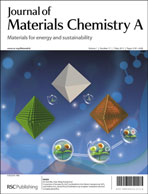The “Hydrogen economy” as an energy solution has received worldwide attention. Development of efficient, economic and recyclable catalysts for hydrogen generation from hydrogen storage materials (e.g., NH3BH3, AB) under moderate conditions has been one of the most active research areas. In the well-studied transition metals, cobalt (Co) and copper (Cu) are very efficient catalysts towards NH3BH3 dehydrogenation. In this work, we demonstrate the preparation of binary Cu–Co catalysts via the LDH precursor approach, which exhibit largely enhanced catalytic activity towards dehydrogenation of AB. The catalyst with a Cu/Co molar ratio of 1/1 yields a hydrolysis completion time less than 4.0 min at a rate of ∼1000 mL (min−1 gcat) under the ambient conditions, comparable to the most reported noble metal catalysts (e.g., Ru, Pt). XRD, H2-TPR, XPS and HRTEM measurements verify that the synergistic effect between highly dispersive metallic Cu and Co3O4 species plays a key role in the significantly enhanced activity of the Cu–Co catalyst. In addition, a monolithic Cu–Co film catalyst was fabricated by an in situ growth-reduction method, which displays further enhanced catalytic activity, recyclability and long-term reusability. This work provides an effective strategy for the fabrication of excellent Cu–Co catalysts for NH3BH3 decomposition, which can be used as promising candidates in pursuit of practical implementation of AB as a hydrogen storage material.

You have access to this article
 Please wait while we load your content...
Something went wrong. Try again?
Please wait while we load your content...
Something went wrong. Try again?


 Please wait while we load your content...
Please wait while we load your content...